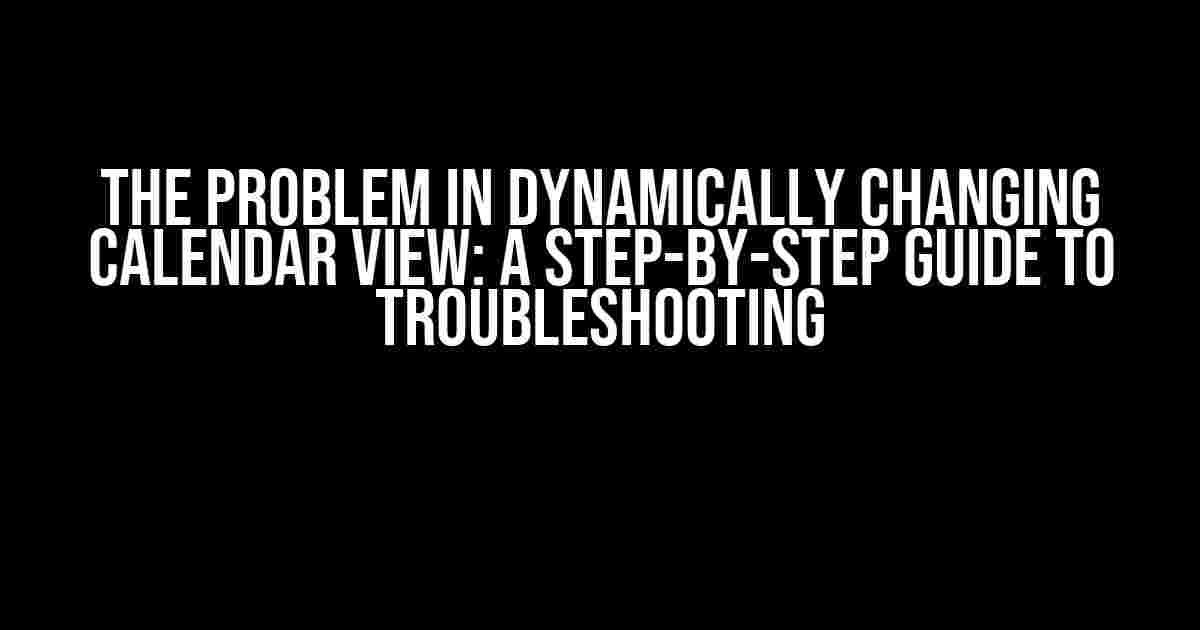If you’re struggling to dynamically change your calendar view, you’re not alone! Many developers have faced this issue, and it can be frustrating to pinpoint the problem. But fear not, dear reader, for we’re about to dive into the world of calendar conundrums and emerge victorious on the other side.
What’s the Problem?
Before we begin, let’s define the problem. Dynamically changing calendar view refers to the ability to switch between different calendar views (e.g., day, week, month) without reloading the entire page. This is typically achieved using JavaScript and DOM manipulation. However, when implementing this feature, you might encounter issues, such as:
- Calendar not updating correctly
- Events not displaying in the correct view
- Layout inconsistencies
Cause of the Problem
So, what’s causing this pesky problem? There are several common culprits:
- JavaScript errors: A single JavaScript error can prevent the entire calendar from functioning correctly.
- DOM manipulation issues: Incorrect DOM manipulation can lead to layout inconsistencies and incorrect event display.
- Inadequate event binding: Failing to rebind events after dynamically changing the calendar view can cause issues.
- Plugin or library incompatibilities: Using multiple plugins or libraries can lead to conflicts and calendar view issues.
Step-by-Step Troubleshooting
Now that we’ve identified the likely causes, let’s work through a step-by-step troubleshooting process to resolve the issue:
Step 1: Check for JavaScript Errors
// Open your browser's console and check for any JavaScript errors
console.log('Checking for JavaScript errors...');
If you find any errors, fix them and retry your dynamically changing calendar view.
Step 2: Verify DOM Manipulation
// Use your browser's developer tools to inspect the DOM
console.log('Inspecting the DOM...');
Ensure that the DOM is being manipulated correctly and that the calendar view is being updated as expected. Look for any inconsistencies in the HTML structure or CSS styling.
Step 3: Rebind Events
// After dynamically changing the calendar view, rebind events using a library like jQuery
$(document).ready(function() {
$('#calendar').on('click', 'event', function() {
// Event handling code here
});
});
Rebinding events ensures that the calendar view is correctly updated and that events are triggered as expected.
Step 4: Check Plugin and Library Incompatibilities
If you’re using multiple plugins or libraries, try isolating each one to identify any potential conflicts:
| Plugin/Library | Version | Compatibility |
|---|---|---|
| FullCalendar | v3.10.2 | Compatible with jQuery 3.x |
| Bootstrap | v4.5.2 | Incompatible with jQuery 3.x |
In this example, we’ve identified a potential conflict between FullCalendar and Bootstrap. Try updating or replacing incompatible plugins or libraries to resolve the issue.
Real-World Example: Implementing a Dynamic Calendar View with FullCalendar
Let’s implement a dynamic calendar view using FullCalendar and jQuery:
<div id="calendar"></div>
<script>
$(document).ready(function() {
var calendar = $('#calendar').fullCalendar({
defaultView: 'month',
events: [
{
title: 'Event 1',
start: '2023-03-01'
},
{
title: 'Event 2',
start: '2023-03-15'
}
]
});
// Dynamically change the calendar view
$('#view-button').click(function() {
var viewType = ($(this).html() === 'Month') ? 'week' : 'month';
calendar.fullCalendar('changeView', viewType);
});
});
</script>
In this example, we’ve created a dynamic calendar view that switches between month and week views when the user clicks a button.
Conclusion
Troubleshooting a dynamically changing calendar view can be a daunting task, but by following these steps, you’ll be well on your way to resolving the issue. Remember to check for JavaScript errors, verify DOM manipulation, rebind events, and investigate plugin and library incompatibilities. With patience and persistence, you’ll be enjoying a seamless calendar view experience in no time!
Happy coding, and don’t forget to share your calendar view conquests in the comments below!
Frequently Asked Question
Got stuck with dynamically changing calendar views? Don’t worry, we’ve got you covered!
Why does my calendar view not update when I change the date range?
This is likely due to the fact that your calendar component is not properly bound to the date range change event. Make sure to update the calendar’s data source when the date range changes, and refresh the calendar view to reflect the new data.
How can I prevent my calendar from flickering when I dynamically change the view?
To avoid flickering, you can use a technique called “virtualization”. This involves only rendering the visible elements in the calendar view and recycling them when the view changes. You can also optimize the calendar’s layout and rendering algorithms to reduce the number of DOM mutations.
Can I use a single calendar component to display multiple date ranges?
Yes, you can! One approach is to use a single calendar component and update its data source and configuration based on the selected date range. Another approach is to use multiple calendar components, each displaying a different date range, and toggle their visibility based on the user’s selection.
How do I handle conflicts between multiple calendars with different date ranges?
When dealing with multiple calendars, you can use a queue-based approach to handle conflicts. This involves queuing up the updates to the calendar views and processing them in the correct order, ensuring that the views are updated correctly and without conflicts.
What are some best practices for optimizing the performance of dynamically changing calendar views?
Some best practices include using caching, lazy loading, and efficient data structures to reduce the amount of data being processed and rendered. Additionally, minimizing DOM mutations, using requestAnimationFrame, and debouncing updates can also improve performance.
